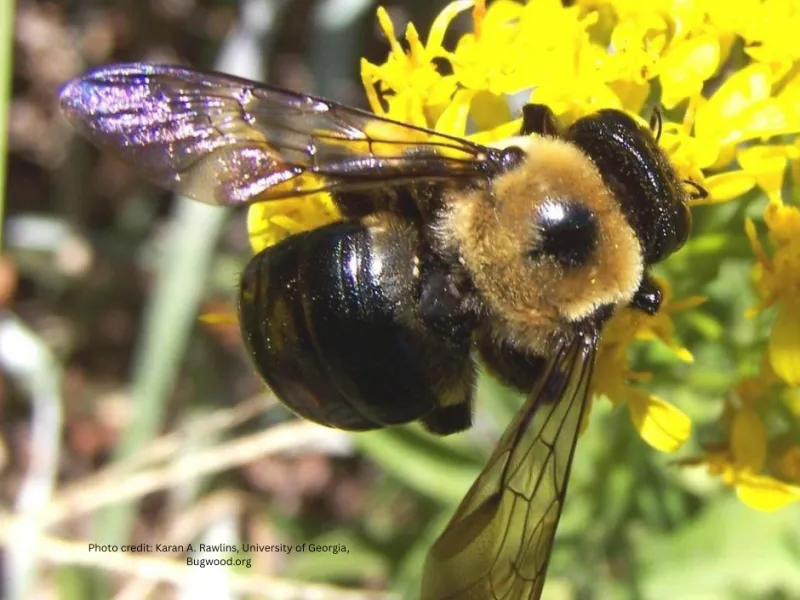What Are Carpenter Bees?

What Are Carpenter Bees?
Carpenter bees are large, solitary insects—often mistaken for bumblebees. However, unlike their fuzzy cousins, these hard-working bees have shiny, hairless abdomens and overwintering females … and are notorious for burrowing into wood to build nests.
Carpenter Bees in the DMV Region
In the Washington, DC metropolitan area, carpenter bees emerge in April and May, with peak drilling activity occurring in May, making spring and early summer prime months for homeowners to stay vigilant.
They're common across Virginia, Maryland, and the District, particularly during warm months.
Infestations become pressing concerns in the DMV due to the abundance of wooden decks, unpainted siding, and aging pergolas that these bees find irresistible.
How Carpenter Bees Damage Wood
Female carpenter bees use powerful mandibles to bore round entrance holes (~½-inch in diameter) into wood, delving about 1 inch deep, then branching off into tunnels 4-6 inches long.
They don't eat wood like termites, but repeated nesting leads to intricate tunnel networks that can span several feet, weakening structural integrity.
Signs of Carpenter Bees
Look for sawdust (frass) beneath drill sites, perfectly round holes, and sometimes staining from bee excrement.
Homeowners may hear buzzing inside wood, and woodpecker pecking may occur as birds hunt larvae.
Male bees may dive-bomb when defending nesting sites—a startling but typically harmless display.
Over time, repeated nesting may compromise decks, fences, siding, window frames, and rafters, especially when woodpecker activity compounds the damage.
Regional Hotspots in the DMV
Carpenter bee activity varies across the DMV area, with certain regions experiencing more intense infestations. In Northern Virginia, particularly around Fairfax and Alexandria, these pests are especially prevalent due to the region's unique blend of newer developments and older homes, many of which feature exposed or untreated wood that appeals to nesting bees. Meanwhile, Southern Maryland often sees increased carpenter bee activity as well, especially in neighborhoods with aging wooden decks, fences, and outdoor furniture that provide ideal nesting spots. Across the entire DMV, older homes with unfinished or weathered wood continue to be prime targets, underscoring the importance of preventative maintenance and early intervention.
Carpenter Bee Prevention & Protection
Make wood less inviting by painting or staining your wood—especially cedar, pine, redwood, and cypress—to harden and repel nesting efforts.
Spray citrus, lavender, or citronella oils near potential nesting areas—these scents are highly repellent to carpenter bees..
Install carpenter bee traps—wooden blocks with holes mimic natural nesting sites but trap bees in jars beneath.
Call the PestNow experts at 877-284-2466
Why Choose PestNow?
Local Expertise - We understand the DMV climate and the peak season of carpenter bees in the region.
Eco-Conscious Solutions - We offer both chemical-free deterrents and targeted treatments, protecting both your home and local pollinators.
Comprehensive Care - Inspection ➝ Treatment ➝ Restoration ➝ Ongoing prevention.
FAQ - Frequently Asked Questions
What time of year are carpenter bees active in the DMV? - Peak activity occurs in April-May, with possible secondary emergence in late summer.
Can painted wood still get infested? - Painting helps, but isn't foolproof. Sealing and full coatings offer the best protection.
Do carpenter bees sting people? - Female bees can sting, but rarely do unless handled; male bees dive-bomb but are stingless.
Are they harmful to my property? - Usually cosmetic damage, but heavy infestations or nesting in load-bearing components can weaken structures over time.
How can I naturally repel them? - Use essential oils such as citrus, lavender, and citronella, and install traps. Proper sealing of wood amplifies effectiveness.
When should I call professionals like PestNow? - If you detect multiple holes, hear buzzing inside wood, notice woodpecker activity, or need safe treatment at height, call us for expert help.
Carpenter bees are more than just noisy neighbors—they can threaten the cosmetic and, over time, structural integrity of your home, especially in the DMV area. At PestNow, we blend eco-friendly solutions with professional-grade treatments to protect your property and our local environment.
Want to safeguard your home this summer? Contact PestNow today for a complimentary inspection and a customized carpenter bee management plan.
Photo credit: Karan A. Rawlins, University of Georgia


